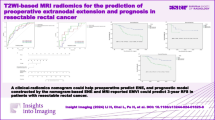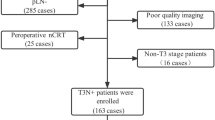Abstract
Objective
To build T2WI-based multiregional radiomics for predicting tumor deposit (TD) and prognosis in patients with resectable rectal cancer.
Materials and methods
A total of 208 patients with pathologically confirmed rectal cancer from two hospitals were prospectively enrolled. Intra- and peritumoral features were extracted separately from T2WI images and the least absolute shrinkage and selection operator was used to screen the most valuable radiomics features. Clinical-radiomics nomogram was developed by radiomics signatures and the most predictive clinical parameters. Prognostic model for 3-year recurrence-free survival (RFS) was constructed using univariate and multivariate Cox analysis.
Results
For TD, the area under the receiver operating characteristic curve (AUC) for intratumoral radiomics model was 0.956, 0.823, and 0.860 in the training cohort, test cohort, and external validation cohort, respectively. AUC for the peritumoral radiomics model was 0.929, 0.906, and 0.773 in the training cohort, test cohort, and external validation cohort, respectively. The AUC for combined intra- and peritumoral radiomics model was 0.976, 0.918, and 0.874 in the training cohort, test cohort, and external validation cohort, respectively. The AUC for clinical-radiomics nomogram was 0.989, 0.777, and 0.870 in the training cohort, test cohort, and external validation cohort, respectively. The prognostic model constructed by combining intra- and peritumoral radiomics signature score (radscore)–based TD and MRI-reported lymph nodes metastasis (LNM) indicated good performance for predicting 3-year RFS, with AUC of 0.824, 0.865, and 0.738 in the training cohort, test cohort and external validation cohort, respectively.
Conclusion
Combined intra- and peritumoral radiomics model showed good performance for predicting TD. Combining intra- and peritumoral radscore-based TD and MRI-reported LNM indicated the recurrence risk.
Clinical relevance statement
Combined intra- and peritumoral radiomics model could help accurately predict tumor deposits. Combining this predictive model-based tumor deposits with MRI-reported lymph node metastasis was associated with relapse risk of rectal cancer after surgery.
Key Points
• Combined intra- and peritumoral radiomics model provided better diagnostic performance than that of intratumoral and peritumoral radiomics model alone for predicting TD in rectal cancer.
• The predictive performance of the clinical-radiomics nomogram was not improved compared with the combined intra- and peritumoral radiomics model for predicting TD.
• The prognostic model constructed by combining intra- and peritumoral radscore-based TD and MRI-reported LNM showed good performance for assessing 3-year RFS.






Similar content being viewed by others
Abbreviations
- AUC:
-
Areas under the receiver operating characteristic curve
- CA199:
-
Carbohydrate antigen 199
- CEA:
-
Carcinoembryonic antigen
- CI:
-
Confidence interval
- DCA:
-
Decision curve analysis
- EMVI:
-
Extramural vascular invasion
- ICC:
-
Intraclass correlation coefficient
- LASSO:
-
Least absolute shrinkage selection operator
- LNM:
-
Lymph node metastasis
- MRF:
-
Mesorectal fascia
- OR:
-
Odds ratio
- Radscore:
-
Radiomics signature score
- RFS:
-
Recurrence-free survival
- ROC:
-
Receiver operating characteristic
- T2WI:
-
T2-weighted imaging
- TD:
-
Tumor deposits
References
Sung H, Ferlay J, Siegel RL et al (2021) Global Cancer Statistics 2020: GLOBOCAN Estimates of Incidence and Mortality Worldwide for 36 Cancers in 185 Countries. CA Cancer J Clin 71(3):209–249
Nagtegaal ID, Knijn N, Hugen N et al (2017) Tumor deosits in colorectal cancer: improving the value of modern staging-a systematic review and meta-analysis. J Clin Oncol 35:1119–1127
Bouquot M, Creavin B, Goasguen N et al (2018) Prognostic value and characteristics of N1c colorectal cancer. Colorectal Dis 20(9):O248-o255
Liu FQ, Zhao J, Li C et al (2019) The unique prognostic characteristics of tumor deposits in colorectal cancer patients. Ann Transl Med 7(23):769
Benoit O, Svrcek M, Creavin B et al (2020) Prognostic value of tumor deposits in rectal cancer: a monocentric series of 505 patients. J Surg Oncol 122(7):1481–1489
Glynne-Jones R, Wyrwicz L, Tiret E et al (2018) Rectal cancer: ESMO Clinical Practice Guidelines for diagnosis, treatment and follow-up. Ann Oncol 29(Suppl 4):iv263
Diagnosis, Treatment Guidelines For Colorectal Cancer Working Group C (2019) Chinese Society of Clinical Oncology (CSCO) diagnosis and treatment guidelines for colorectal cancer 2018 (English version). Chin J Cancer Res 31(1):117–134
Lambregts DMJ, Bogveradze N, Blomqvist LK et al (2022) Curret controversies in TNM for the radiological staging of rectal cancer and how to deal with them: results of a global online survey and multidisciplinary expert consensus. Eur Radiol 32(7):4991–5003
Lord AC, Moran B, Abulafi M et al (2020) Can extranodal tumour deposits be diagnosed on MRI? Protocol for a multicentre clinical trial (the COMET trial). BMJ Open 10(10):e033395
Yang YS, Feng F, Qiu YJ, Zheng GH, Ge YQ, Wang YT (2021) High-resolution MRI-based radiomics analysis to predict lymph node metastasis and tumor deposits respectively in rectal cancer. Abdom Radiol (NY) 46(3):873–884
Shin J, Seo N, Baek SE et al (2022) MRI radiomics model predicts pathologic complete response of rectal cancer following chemoradiotherapy. Radiology 303(2):351–358
Yuan Y, Lu H, Ma X et al (2022) Is rectal filling optimal for MRI-based radiomics in preoperative T staging of rectal cancer? Abdom Radiol (NY) 47(5):1741–1749
Yuan Y, Chen XL, Li ZL et al (2022) The application of apparent diffusion coefficients derived from intratumoral and peritumoral zones for assessing pathologic prognostic factors in rectal cancer. Eur Radiol 32(8):5106–5118
Hu Y, Xie C, Yang H et al (2020) Assessment of intratumoral and peritumoral computed tomography radiomics for predicting pathological complete response to neoadjuvant chemoradiation in patients with esophageal squamous cell carcinoma. JAMA Netw Open 3:e2015927
Orel VE, Ashykhmin A, Golovko T, Rykhalskyi O, Orel VB (2021) Texture analysis of tumor and peritumoral tissues based on 18F-fluorodeoxyglucose positron emission tomography/computed tomography hybrid imaging in patients with rectal cancer. J Comput Assist Tomogr 45:820–828
Nelson DA, Tan TT, Rabson AB, Anderson D, Degenhardt K, White E (2004) Hypoxia and defective apoptosis drive genomic instability and tumorigenesis. Genes Dev 18:2095–2107
Jin YM, Li M, Zhao YL et al (2021) Computed tomography-based radiomics for preoperative prediction of tumor deposits in rectal cancer. Front Oncol 11:710248
Shin J, Seo N, Baek SE et al (2022) MRI radiomics model predicts pathologic complete response of rectal cancer following chemoradiotherapy. Radiology 303(2):351–358
Amin MB, Greene FL, Edge SB et al (2017) The Eighth Edition AJCC Cancer Staging Manual: continuing to build a bridge from a population-based to a more “personalized” approach to cancer staging. CA Cancer J Clin 67(2):93–9
Beets-Tan RGH, Lambregts DMJ, Maas M et al (2018) Magnetic resonance imaging for clinical management of rectal cancer: Updated recommendations from the 2016 European Society of Gastrointestinal and Abdominal Radiology (ESGAR) consensus meeting. Eur Radiol 28(4):1465–1475
Jiang Y, Wang H, Wu J et al (2020) Noninvasive imaging evaluation of tumor immune microenvironment to predict outcomes in gastric cancer. Ann Oncol 31(6):760–768
Orlhac F, Lecler A, Savatovski J et al (2021) How can we combat multicenter variability in MR radiomics? Validation of a correction procedure. Eur Radiol 31:2272–2280
Pizzi AD, Chiarelli AM, Chiacchiaretta P et al (2021) MRI-based clinical-radiomics model predicts tumor response before treatment in locally advanced rectal cancer. Sci Rep 11(1):5379
Chen LD, Li W, Xian MF et al (2020) Preoperative prediction of tumour deposits in rectal cancer by an artificial neural network-based US radiomics model. Eur Radiol 30(4):1969–1979
Puppa G, Maisonneuve P, Sonzogni A et al (2007) Pathological assessment of pericolonic tumor deposits in advanced colonic carcinoma: relevance to prognosis and tumor staging. Mod Pathol 20(8):843–855
Yamano T, Semba S, Noda M et al (2015) Prognostic significance of classified extramural tumor deposits and extracapsular lymph node invasion in T3–4 colorectal cancer: a retrospective single-center study. BMC Cancer 15:859
Wang X, Zhao X, Li Q et al (2019) Can peritumoral radiomics increase the efficiency of the prediction for lymph node metastasis in clinical stage T1 lung adenocarcinoma on CT? Eur Radiol 29:6049–6058
Ding J, Chen S, Serrano SM et al (2022) Optimizing the Peritumoral Region Size in Radiomics Analysis for Sentinel Lymph Node Status Prediction in Breast Cancer. Acad Radiol 29(Suppl 1):S223–S228
Shi JX, Dong Y, Jiang WY et al (2022) MRI-based peritumoral radiomics analysis for preoperative prediction of lymph node metastasis in early-stage cervical cancer: a multi-center study. Magn Reson Imaging 88:1–8
Jayaprakasam VS, Paroder V, Gibbs P et al (2022) MRI radiomics features of mesorectal fat can predict response to neoadjuvant chemoradiation therapy and tumor recurrence in patients with locally advanced rectal cancer. Eur Radiol 32(2):971–980
Yu Y, Tan Y, Xie C et al (2020) Development and validation of a preoperative magnetic resonance imaging radiomics-based signature to predict axillary lymph node metastasis and disease-free survival in patients with early-stage breast cancer. JAMA Netw Open 3(12):e2028086
Funding
This study has received funding from the Sichuan Science and Technology Program (grant number, 2020YFH0166) and the Key Research Project of Sichuan Province (grant number, 2022YFS0249).
Author information
Authors and Affiliations
Corresponding author
Ethics declarations
Guarantor
The scientific guarantor of this publication is Hong Pu.
Conflict of interest
H. Liu is a statistician from GE Healthcare and controls of the study data.
The authors of this manuscript declare no relationships with any companies, whose products or services may be related to the subject matter of the article.
Statistics and biometry
Hang Li and Huan Liu kindly provided statistical advice for this manuscript.
Informed consent
Written informed consent was obtained from all patients in this study.
Ethical approval
Institutional Review Board approval was obtained.
Methodology
• prospective
• diagnostic or prognostic study
• performed at two institutions
Additional information
Publisher's note
Springer Nature remains neutral with regard to jurisdictional claims in published maps and institutional affiliations.
Supplementary Information
Below is the link to the electronic supplementary material.
Rights and permissions
Springer Nature or its licensor (e.g. a society or other partner) holds exclusive rights to this article under a publishing agreement with the author(s) or other rightsholder(s); author self-archiving of the accepted manuscript version of this article is solely governed by the terms of such publishing agreement and applicable law.
About this article
Cite this article
Li, H., Chen, Xl., Liu, H. et al. MRI-based multiregional radiomics for preoperative prediction of tumor deposit and prognosis in resectable rectal cancer: a bicenter study. Eur Radiol 33, 7561–7572 (2023). https://doi.org/10.1007/s00330-023-09723-9
Received:
Revised:
Accepted:
Published:
Issue Date:
DOI: https://doi.org/10.1007/s00330-023-09723-9




